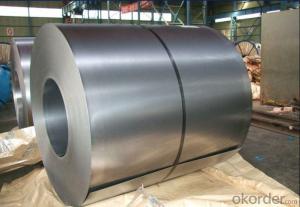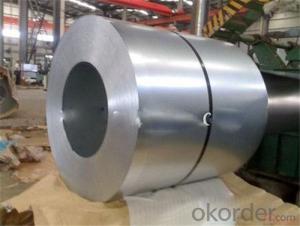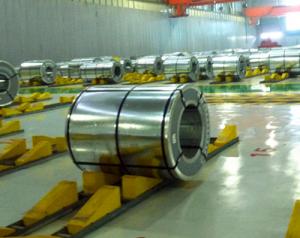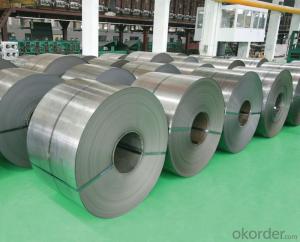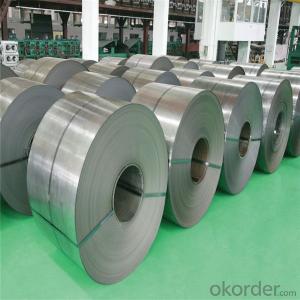THE COLD ROLLED STEEL COILS
- Loading Port:
- China Main Port
- Payment Terms:
- TT OR LC
- Min Order Qty:
- -
- Supply Capability:
- -
OKorder Service Pledge
OKorder Financial Service
You Might Also Like
Cold rolled steel is the based material forgalvanized steel coil and pre-painted galvanized steel coil. It is widely usedin light industry for marking tank, furniture, refrigerators, washers, freezerplate, air conditioner, micro-wave oven, water heater, soot such machine etc.
Main specification:
COLD ROLLED STEEL | |
Thicknenss | 0.10mm-4.00mm |
Width | 600mm-2000mm |
Sheets length | 1200-6000mm |
Coil inner diameter | 508-610mm |
Surface treatement | matt finish/bright finish,oiling/dry, bright anneal/black anneal |
Coil weight | 3-5t |
We can supply customers' with different specifications of the highest quality and lowest price.
Sincerely welcome to contact us for the future details if any item interest you ,and we will make every effort to assure that your requirements will be satisfied ,and we hope to establish long-term business relations with you on the basis of the equality and mutual benefit.
we are waiting for your email.
- Q: What are the typical tolerances for steel coils?
- The typical tolerances for steel coils vary depending on the specific requirements and standards set by the industry. However, common tolerances for steel coils include thickness tolerances of +/- 0.001 to 0.005 inches, width tolerances of +/- 0.005 to 0.050 inches, and length tolerances of +/- 0.250 to 0.500 inches. These tolerances ensure that the steel coils meet the desired specifications and can be used effectively in various applications.
- Q: Hi I was thinking about buying this knife, but i wasn't sure if it was good because it's stainless steel.
- This isn't really a question for this section, but I'm still happy to help out since I'm a big cutlery nerd as well. One thing to look out for when buying a knife is a lack of specifics on what steel is being used. High Carbon Stainless Steel doesn't tell you what the steel is, just what it MIGHT be. Chances are it's something along the lines of 420HC or 440A, both of which are softer steels. They aren't the worst steels around, but they are very quick to dull. You'd be better off looking at the Balisongs of Benchmade. They'll cost more, but you'll know that you're getting something made with quality materials and that won't break on you. And if it does break for some odd reason, Benchmade's warranty and customer service are both fantastic. Although if a more questionable knife is okay with you as long as the price isn't too high, then at least 420HC and 440A aren't too brittle and will take a decent edge even though they'll dull quickly. As for whether stainless steel is good for a knife or not, that depends on the type of stainless steel and what you're going to use the knife for. Many stainless steels are more brittle than a carbon steel, so high carbon stainless steels are a bit more likely to rust but a little tougher as well. In a butterfly knife, a steel like that is a good way to go, although the steels used by Benchmade, as I mentioned, are of a much better quality.
- Q: I just bought a used Taurus 85 stainless 38 spl revolver, it's about 25 years old but looks like new. This is my first stainless steel gun. I'm wondering if there's any special things I need to be aware of or cleaning methods? I'm also wondering if stainless steel could rust? in theory stainless means it cannot get stained or rusty. I have a chrome bore AK, cleaning is always super easy, wondering of cleaning a SS revolver would be the same.
- Q: will a stainless steel gun rust? A: Under certain conditions, it can rust. But stainless steel will last longer than blued steel will under such conditions. Also, some parts of a stainless steel revolver might not be stainless steel. The internal parts may be normal steel. Q: I just bought a used Taurus 85 stainless 38 spl revolver, it's about 25 years old but looks like new. This is my first stainless steel gun. I'm wondering if there's any special things I need to be aware of or cleaning methods? A: There are no special methods required. Stainless steel is fairly convenient easy to clean and maintain. Carbon-fouling can still build-up and metal discolorations may occur. These can be cleaned up with cleaning solvents and the use of a Scotch-brite cleaning pad or something similar. If it gets a scratch, the scratch can be polished away or left alone and the scratch can become a badge of honor or something. Q: I have a chrome bore AK, cleaning is always super easy, wondering of cleaning a SS revolver would be the same. A: Stainless steel is pretty tough on its own. Chrome-lining a stainless steel barrel wouldn't be considered cost effective in most circumstances. Cleaning the inside of a stainless steel barrel will be similar to cleaning a blued steel barrel that is not chrome-lined.
- Q: What we have to keep in mind before buying a steel building?
- Here is a web search of the term steel building specification. It should give you some ideas and sources.
- Q: What are the different types of steel coil packaging?
- Various industries use different methods to package steel coils. Some common types include: 1. Wooden Crates: Steel coils are often placed in wooden crates for transportation and storage. These crates effectively protect against damage and ensure secure transit. 2. Steel Frame Bundles: Steel coils are tightly strapped together using steel bands or wires, creating a sturdy bundle that can be easily lifted and moved with cranes or forklifts. This method is suitable for vertical stacking. 3. Steel Strapping: Steel coils can also be packaged using steel strapping. Straps are tightly wrapped around the coils to secure them in place, providing protection against movement and damage during transportation. 4. VCI (Volatile Corrosion Inhibitor) Packaging: VCI packaging is ideal for preventing corrosion during storage and shipment. The coils are wrapped in special VCI film or paper that releases corrosion-inhibiting molecules, ensuring the coils remain rust-free. 5. Cardboard Packaging: Smaller steel coils or those needing extra protection can be packaged in cardboard boxes or cartons. The coils are placed inside and the box is sealed, creating a barrier against damage and contamination. 6. Stretch Wrapping: Plastic film is tightly wrapped around the steel coils, creating a secure and protective layer. This method is useful when coils need protection from dust, moisture, or other external elements. The choice of steel coil packaging method depends on factors such as size, weight, transportation requirements, and desired level of protection. Each method offers its own advantages and is chosen based on industry needs and coil specifications.
- Q: How are steel coils uncoiled?
- Steel coils are typically uncoiled using a machine called a decoiler or uncoiler, which gradually unwinds the coil by feeding it through a set of rollers. The rollers apply tension to the coil, allowing it to unwind smoothly and evenly. The speed and direction of the uncoiling process can be controlled to match the specific requirements of the application.
- Q: How do steel coils withstand extreme temperatures?
- Steel coils are able to withstand extreme temperatures due to the unique properties of steel. Firstly, steel has a high melting point, allowing it to maintain its structural integrity even at extremely high temperatures. Additionally, steel has excellent thermal conductivity, which enables it to evenly distribute and dissipate heat. Furthermore, steel undergoes various heat treatment processes during manufacturing, such as quenching and tempering, which enhance its strength and resistance to temperature fluctuations. Overall, these factors make steel coils highly capable of withstanding extreme temperatures.
- Q: I heard about a new bike the specialized allez steel. Has anyone heard anything about it. it will have all brand new components like shimano 2300 parts and everything. it looks nice.
- Steel? I doubt it's made out of steel, more labor and a heavier frame. Most likely aluminum. Shimano 2300 you say? The Shimano 2300 is the lowest of the low of Shimano road components. Most likely not too reliable and heavy. www.cyclestore .uk/productDetai... I think this is what you might be looking for.
- Q: How are steel coils inspected for coil set using deflection measurement?
- Coil set, a condition where a steel coil exhibits a curvature along its length, is commonly inspected using deflection measurement techniques. These techniques involve applying force to the coil and measuring the resulting deviation from its original shape. To inspect for coil set, a steel coil is placed on a testing apparatus capable of applying controlled pressure. Typically, this apparatus consists of rollers or hydraulic cylinders that can exert force on the coil's surface. The first step in the inspection process involves securing the coil in place to ensure proper alignment and centering on the testing apparatus. Once the coil is positioned correctly, the apparatus applies a known force along its length. This force is consistently and controlledly applied to ensure accurate measurements. During the application of force, sensors or gauges positioned at specific points along the coil's length measure its deflection. These sensors can detect even minor deviations from the coil's original shape. The deflection measurements are recorded and analyzed to determine the severity of coil set. Typically, a set of predefined acceptance criteria is used to assess the coil's condition. If the recorded deflection measurements exceed these criteria, it indicates the presence of coil set. The severity of the coil set can be determined by comparing the actual deflection measurements with the acceptable range specified by the criteria. Deflection measurement is an effective method for inspecting steel coils for coil set since it provides quantitative data on the deviation from the original shape. This information enables manufacturers to identify and address any coil set issues, ensuring the quality of the steel coils before further processing or shipment to customers.
- Q: How are steel coils measured for thickness?
- Steel coils are measured for thickness using a variety of methods. One common method is using a micrometer, which is a precision measuring instrument that accurately determines the thickness of the coil. The micrometer is gently pressed against the surface of the coil and the measurement is taken. Another method involves using a thickness gauge, which is a handheld device that can quickly and accurately measure the thickness of the steel coil. The gauge is placed on the coil's surface and the thickness is displayed on a digital screen. In some cases, ultrasonic thickness testing is used to measure the thickness of steel coils. This method involves using ultrasonic waves that are emitted from a handheld device. The waves travel through the coil and bounce back to the device, providing an accurate measurement of the thickness. Regardless of the method used, it is important to ensure that the measurements are taken at multiple points across the coil to account for any variations in thickness. This ensures that accurate and reliable measurements are obtained.
Send your message to us
THE COLD ROLLED STEEL COILS
- Loading Port:
- China Main Port
- Payment Terms:
- TT OR LC
- Min Order Qty:
- -
- Supply Capability:
- -
OKorder Service Pledge
OKorder Financial Service
Similar products
Hot products
Hot Searches
Related keywords















